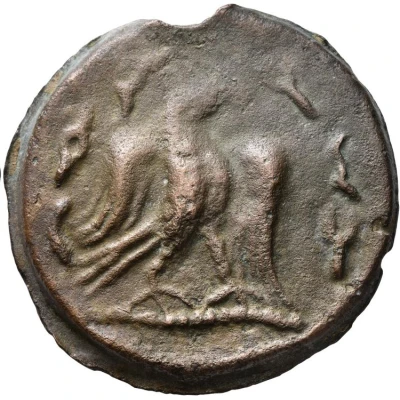


© Leu Numismatik
Unit 100 BC - 100 AD
| Bronze | 62.80 g | 47 mm |
| Issuer | Hadhramautic Kingdom (Southern Arabia) |
|---|---|
| Type | Standard circulation coin |
| Years | 100 BC - 100 AD |
| Currency | Drachm (ca. 300 – 200 BC) |
| Composition | Bronze |
| Weight | 62.80 g |
| Diameter | 47 mm |
| Shape | Round (irregular) |
| Technique | Cast |
| Orientation | Medal alignment ↑↑ |
| Demonetized | Yes |
| Updated | 2024-10-09 |
| Numista | N#221548 |
|---|---|
| Rarity index | 93% |
Reverse
Eagle standing right with wings spread; to left, 𐩧𐩤𐩦 ('sqr' in South Arabian); to right, 𐩠𐩦𐩺 ('ysh' in South Arabian).
Script: Ancient South Arabian
Lettering: 𐩧𐩤𐩦 𐩠𐩦𐩺
Comment
CNG 99 (2015), lot 375.Munro-Hay pl. IX, 257
There has been some debate over the dating of these large cast bronzes, with suggestions ranging from the 1st century BC to as late as the 4th century AD. Perhaps they were produced and circulated over a longer period of time, which might also explain the great weight differences in the series, which range from 16.00 to 87.85 g. In addition, no final conclusion over the interpretation of the legends has been reached to date, but it seems clear that 'syn' refers to the moon god sayin (or sin), whereas 'sqr' stands for a Hadrami coin and 'ysh', perhaps, for a personal name (Yashur?). (source: Leu Numismatik AG Auction 4 catalog, lot 384)
Interesting fact
One interesting fact about this coin is that it features a unique blend of Indian and Greek influences in its design, reflecting the multicultural nature of the Hadhramautic Kingdom during that time period. The coin's obverse side depicts a crowned king with a long beard, while the reverse side shows a lion attacking a bull, which is a common motif in ancient Indian coinage. This fusion of design elements from different cultures is a testament to the rich cultural heritage of the Hadhramautic Kingdom.